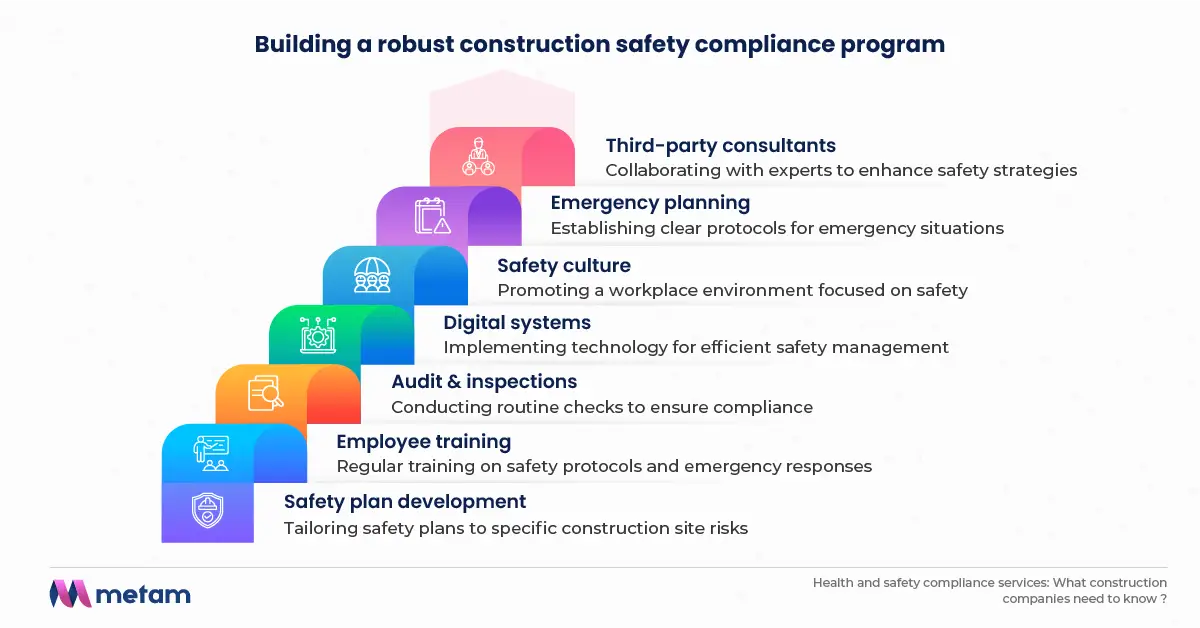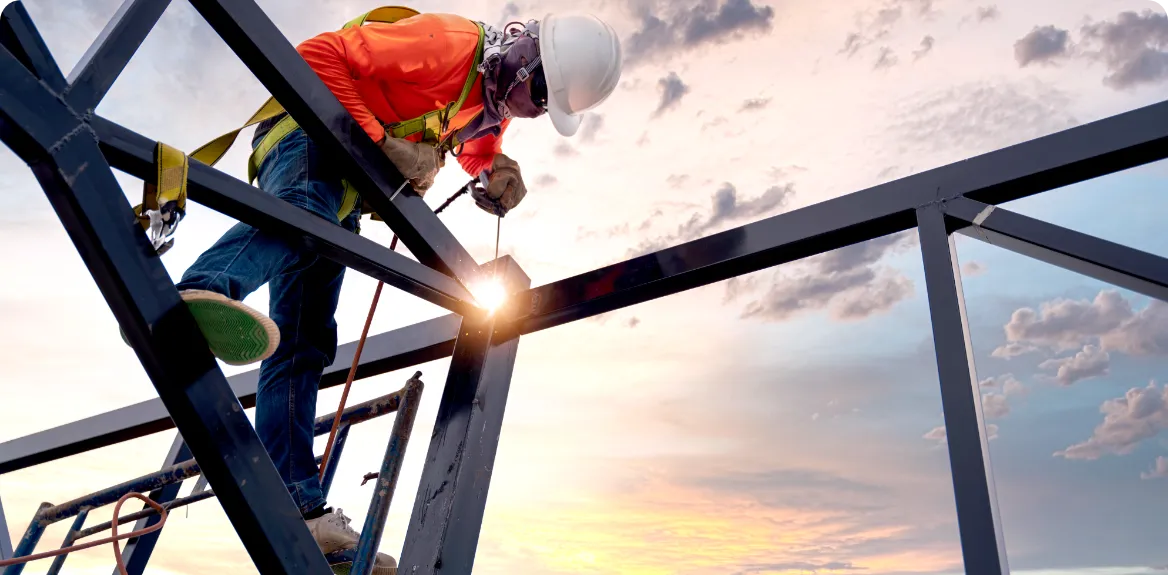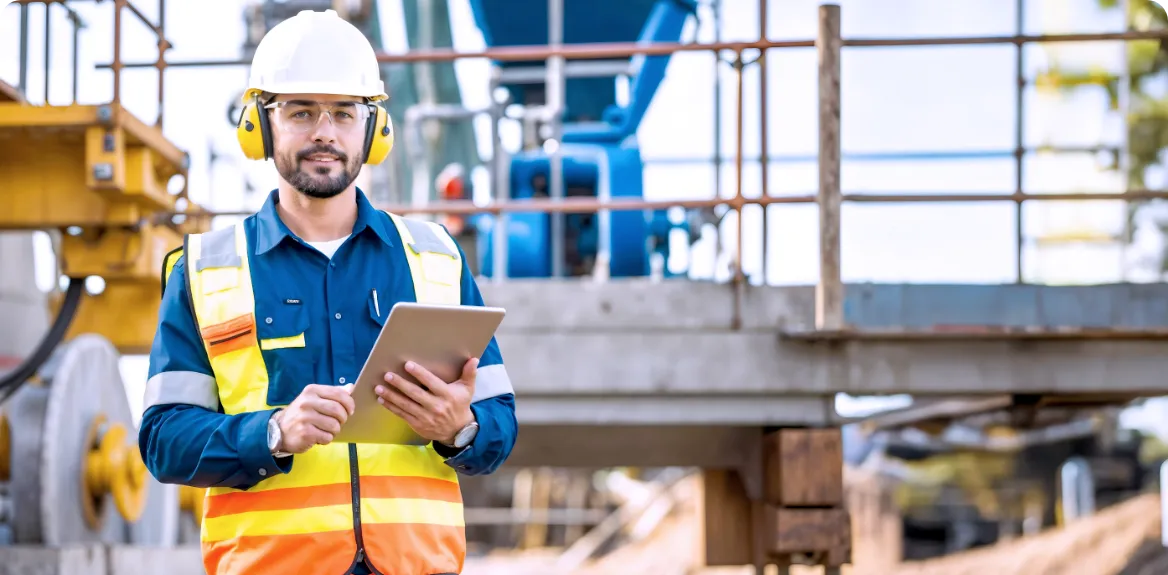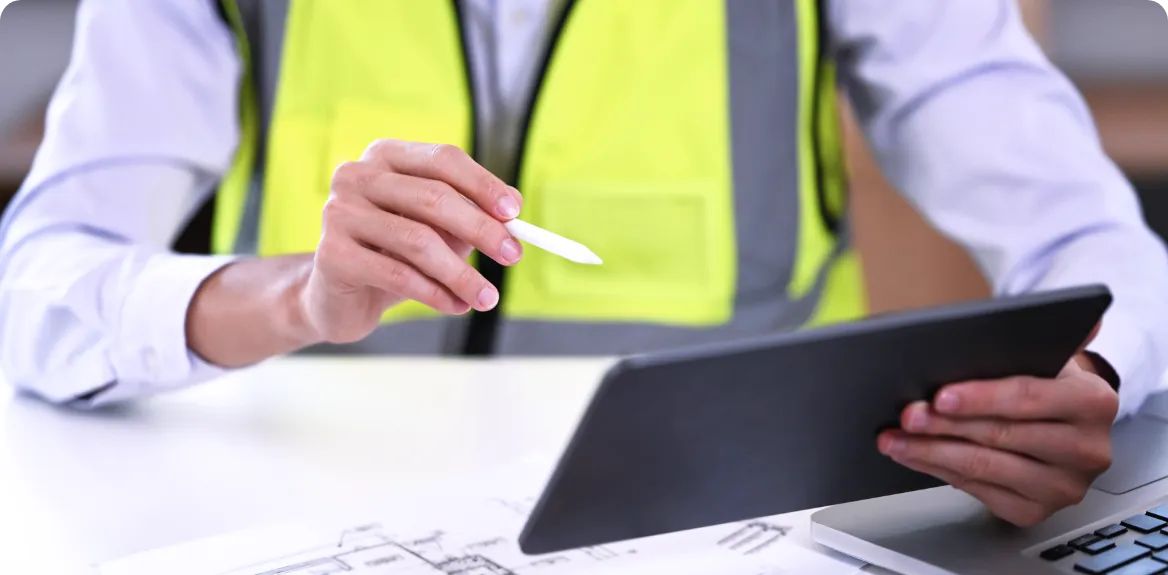Health and safety compliance services: What construction companies need to know ?
by
Metam technologies

Abstract
Explore essential health and safety compliance services for construction companies. This guide covers key safety compliance solutions, industry regulations, and best practices to reduce risks, ensure legal adherence, and enhance worker safety. Learn how these services help companies stay compliant while improving overall workplace safety.
Table of Content
What are health and safety compliance services in construction?

Why are safety compliance solutions essential for construction companies?

How can construction companies implement effective safety compliance programs?

How do safety compliance services adapt to emerging trends in construction?

What are the benefits of partnering with professional safety compliance services?

How Metam Technologies is transforming construction safety compliance ?

In the high-risk construction industry, health and safety compliance services are essential for ensuring legal compliance and protecting workers. With the construction safety service market projected to grow from $9.5 billion in 2023 to $15.2 billion by 2032, the demand for safety compliance services and solutions is on the rise.
These services not only help companies meet regulatory standards but also improve workplace safety, reduce accidents, and enhance operational efficiency.
This article explores the key components and benefits of safety compliance services, along with emerging trends in the industry.
What are health and safety compliance services in construction?
Health and safety compliance services are integral to ensuring construction companies meet the legal standards and best practices for worker protection and operational safety. These services help companies navigate complex regulations, minimize accidents, and improve overall safety performance.
Defining safety compliance for construction companies
Safety compliance in construction refers to the set of services and protocols designed to ensure a company meets all necessary regulatory requirements to protect workers on-site. This includes risk assessments, regular safety audits, compliance audits, and the development of safety policies tailored to construction-specific needs. Having a robust compliance framework is essential for reducing accidents and ensuring legal protection in the event of workplace incidents.
By adhering to these safety practices, construction firms can protect both their workers and their bottom line from unforeseen costs associated with accidents and non-compliance.
Core components of safety compliance solutions
Key components of safety compliance solutions for construction companies include safety training programs, equipment inspections, emergency preparedness, and ongoing hazard assessments. These elements ensure that safety protocols are ingrained into the company’s culture. Regular training programs help ensure workers stay up-to-date on the latest safety protocols, while equipment inspections ensure all machinery and tools are safe to use. Effective emergency preparedness plans help companies respond swiftly in case of an incident, minimizing the potential for injury or fatality.
Comprehensive safety solutions are critical for preventing accidents and ensuring that all regulatory requirements are continuously met.
Compliance vs. best practices, what’s the difference?
While compliance ensures a company meets the legal requirements set by regulatory bodies, adopting industry best practices goes beyond simply following the law. Best practices include proactive strategies to create a safer and more efficient workplace by adopting the latest safety technologies, conducting regular audits, and fostering a culture of safety.
The gap between compliance and best practices can be vast, with many companies focusing solely on compliance, which may leave gaps in their overall safety strategy.
Why are safety compliance solutions essential for construction companies?
Ensuring compliance with health and safety regulations is vital for construction companies. Failure to comply can lead to serious consequences, including hefty fines, lawsuits, and a damaged reputation. Implementing safety compliance solutions can mitigate risks, ensure worker safety, and enhance a company's operational efficiency.
Understanding OSHA and industry-specific regulations
OSHA regulations are designed to protect workers in high-risk environments like construction. These standards cover everything from worker training to equipment maintenance and personal protective equipment (PPE) requirements. Construction companies must be well-versed in these regulations to avoid penalties and legal challenges.
In 2025, new OSHA regulations focus on ensuring the proper fit of PPE, addressing heat illness prevention, and reducing lead exposure limits, requiring companies to adopt stricter measures for worker safety. Understanding and adapting to these updated regulations is crucial to avoiding non-compliance issues.
The financial impact of non-compliance
The financial ramifications of non-compliance are far-reaching, ranging from fines and legal fees to increased insurance premiums and workplace accident costs. In addition, workplace accidents often lead to costly project delays and productivity losses. Investing in safety compliance solutions can significantly reduce these financial risks by preventing incidents and ensuring that a company remains within legal parameters.
By integrating compliance solutions, companies not only save on potential fines but also reduce the risk of work stoppages and liabilities.
Enhancing worker safety and reducing liability
Health and safety compliance services directly impact worker safety by enforcing regulations that protect employees from hazards on the job. By ensuring safety measures are followed, companies can minimize accidents and injuries, reducing their exposure to legal liabilities.
With a focus on proactive safety measures, construction firms can foster a safer environment, reducing the likelihood of workplace accidents and ensuring employees are better protected.
Improving company reputation and competitiveness
Complying with health and safety regulations helps construction companies build a strong reputation for being responsible and ethical. This reputation is valuable for attracting clients and employees who prioritize safety. A company that invests in safety compliance services can showcase its commitment to the well-being of its workforce and demonstrate a strong safety record, which sets it apart from competitors.
A robust safety program also improves client trust, which can lead to more projects and greater business opportunities.
Mitigating project delays and enhancing efficiency
When a construction company fails to meet safety standards, it risks project delays due to inspections, stoppages, or legal interventions. Regular safety audits, employee training, and inspections help avoid these disruptions by maintaining compliance and fostering a safer, more efficient work environment. Proactively addressing safety issues ensures smoother project timelines and reduces costly downtime.
How can construction companies implement effective safety compliance programs?
Implementing an effective safety compliance program is essential for maintaining workplace safety and meeting regulatory requirements. From creating a safety plan to adopting new technologies, these strategies can enhance compliance efforts across construction sites.

- Developing a construction-specific safety plan: Creating a construction-specific safety plan involves assessing the unique risks associated with different project types. This plan should cover risk assessments, safety protocols, and safety responsibilities for each project. Tailoring a safety plan to meet the specific challenges of each site ensures that compliance measures address the most relevant safety concerns. A well-crafted safety plan helps companies stay organized and proactive in addressing potential hazards on the job site.
- Training employees on safety best practices: Regular safety training is vital for ensuring that all employees understand the risks they face and how to mitigate them. Effective training programs should address everything from equipment usage to proper lifting techniques and emergency response procedures. Regular training ensures that safety remains a priority and that workers are always prepared to handle any situation. Training also helps workers feel more secure, leading to improved morale and better overall safety performance.
- Conducting regular audits and inspections: Routine safety audits and inspections help ensure that compliance is maintained throughout the duration of a project. Regular inspections identify any hazards that may have gone unnoticed and ensure that safety protocols are followed. These audits provide an opportunity to make adjustments and prevent potential issues before they become problems. Consistency in inspections is key to maintaining long-term safety and compliance.
- Leveraging digital compliance management systems: Using digital compliance management systems simplifies tracking and reporting safety activities, ensuring timely documentation of safety inspections and training. These systems can also automate regulatory updates, providing real-time insights into compliance status. By leveraging technology, construction companies can streamline their safety management processes and improve overall efficiency. Digital tools enhance record-keeping, help prevent human error, and keep companies informed about the latest safety regulations.
- Creating a safety-first workplace culture: A safety-first workplace culture encourages employees to prioritize safety in every task. Leadership should actively promote safety through regular communications, safety incentives, and the inclusion of safety goals in company performance metrics. By making safety a central focus of company values, employees will be more likely to adopt safety-first behaviors. Promoting this culture also increases the chances of identifying potential risks early and addressing them proactively.
- Emergency response planning and incident reporting: Developing clear emergency response plans is critical for dealing with on-site accidents or incidents. These plans should outline procedures for evacuations, medical response, and reporting incidents to the appropriate authorities. Clear and concise protocols ensure that workers can respond quickly in case of an emergency, minimizing injuries and fatalities. Having these plans in place ensures that workers are well-prepared for any situation that might arise, contributing to overall safety on-site.
- The role of third-party compliance consultants: Partnering with third-party compliance consultants provides expert knowledge and ensures that safety protocols are up-to-date and effective. Consultants can offer an outside perspective, identifying potential compliance gaps and helping implement more effective safety strategies. These experts bring a wealth of experience to the table, providing construction companies with insights that may not be available internally.
How do safety compliance services adapt to emerging trends in construction?
As technology advances and the construction industry evolves, safety compliance services must adapt to emerging trends to maintain effectiveness. The integration of new technologies and approaches can significantly enhance safety and streamline compliance processes.
- Digital transformation in construction safety: Digital transformation is reshaping construction safety, with tools like construction management software and mobile apps enabling real-time safety tracking and reporting. By adopting these technologies, construction firms can improve communication, identify safety issues more rapidly, and create a more transparent safety culture. The use of digital tools helps streamline the safety compliance process, making it more efficient and responsive to changing needs.
- The role of wearable safety technology: Wearable safety technology, such as smart helmets, vests, and gloves, is revolutionizing on-site safety. These devices can monitor workers' vital signs, detect falls, and even send alerts if unsafe conditions are detected. By integrating wearable devices, construction companies can provide real-time monitoring and improve safety outcomes. These devices enhance situational awareness, providing both workers and supervisors with crucial data to prevent accidents.
- Sustainable safety practices and green compliance: As sustainability becomes a growing priority in construction, integrating green practices into safety protocols is essential. Green compliance involves adopting safety practices that reduce environmental impact, such as using eco-friendly materials or implementing energy-efficient safety equipment. Fostering sustainable safety practices is not only beneficial for the environment but also enhances a company’s reputation as a responsible and forward-thinking organization.
- Remote training and virtual safety assessments: Virtual reality and remote safety training are becoming increasingly popular in construction safety programs. These technologies provide immersive training experiences that can simulate hazardous scenarios in a controlled environment, ensuring workers are prepared for real-world risks. Using remote platforms ensures continuous training and assessment, even for geographically dispersed teams, improving overall compliance and safety standards.
- Predictive analytics for accident prevention: Predictive analytics can help foresee potential accidents by analyzing data from past incidents, identifying patterns, and predicting future risks. By leveraging this data, construction companies can implement preventive measures before incidents occur, saving lives and reducing costs. Predictive analytics enhances safety by helping companies anticipate risks and proactively implement solutions.
- IoT and smart sensors for real-time safety monitoring: Internet of Things (IoT) devices and smart sensors are increasingly used for real-time safety monitoring. These sensors can detect hazardous conditions like gas leaks, equipment malfunctions, and unsafe environmental conditions, alerting workers and supervisors instantly. By incorporating IoT technology, companies can monitor conditions in real time, ensuring prompt action and minimizing risks.
- Compliance automation with AI and machine learning: AI and machine learning technologies are streamlining compliance processes by automating data analysis, inspections, and report generation. These technologies can identify compliance gaps, ensuring that construction companies stay on top of ever-changing safety regulations. Automation reduces human error and frees up resources, allowing safety managers to focus on more strategic initiatives.
What are the benefits of partnering with professional safety compliance services?
Partnering with professional safety compliance services brings valuable expertise and support to construction companies, ensuring that safety measures are effectively implemented and maintained.
Gaining access to industry experts and specialized knowledge
Professional safety compliance services provide access to experts who have a deep understanding of industry regulations and best practices. These specialists can help companies navigate complex compliance issues and implement effective safety strategies.
Working with experts ensures that companies stay ahead of evolving regulations and best practices, mitigating risks more effectively.
Reducing administrative burden and improving efficiency
Outsourcing safety compliance tasks to professionals reduces the administrative burden on internal teams, allowing them to focus on core business activities. Compliance consultants streamline processes, reducing errors and ensuring that companies remain in compliance with all regulatory requirements.
This approach helps companies save time and resources while improving the efficiency of their safety management efforts.
Enhancing workplace culture and long-term compliance
Professional safety consultants work with companies to build a safety-first culture that prioritizes employee wellbeing. This culture encourages workers to embrace safety practices, leading to sustained compliance and a safer working environment.
By fostering a culture of continuous safety, companies are better prepared to meet long-term compliance requirements and reduce the likelihood of accidents.
How Metam Technologies is transforming construction safety compliance ?
Metam Technologies offers innovative solutions that transform construction safety compliance, providing customized tools and platforms designed to streamline safety management and improve compliance outcomes.
- Construction safety solutions and services: Metam delivers state-of-the-art safety compliance solutions, including risk management platforms, safety audits, and training programs. Their tools integrate seamlessly into existing safety frameworks, providing companies with the resources needed to enhance compliance and reduce risk.
- Metam’s solutions help construction companies remain compliant and improve workplace safety standards.
- Customizable safety management for construction firms: Metam offers customizable safety management tools that can be tailored to meet the unique needs of construction projects. These solutions ensure that companies can adapt to various project risks and regulatory standards, ensuring ongoing compliance and safety. Customizable tools enable companies to implement solutions that are specifically designed for their operational needs.


Construction compliance...
This article explores the transformative role of compliance automation in construction health and safety management,...




